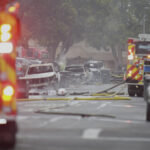Imagine waking up to discover an explosion at the San Onofre Nuclear Generating Station had led to a fire, radioactive leak and evacuations in nearby Southern California communities.
That’s the scene government officials were asked to consider for a drill Tuesday involving a fake disaster at the California plant.
A month after Japan’s devastating earthquake and tsunami, emergency responders and others were given the details at 8 a.m. after arriving at a cavernous Southern California Edison truck bay in Irvine that had been converted into an information center.
Such routine drills have attracted little attention in past years. But this one drew more than two dozen members of the media to watch the exercise.
“Even though this drill this week has been in the planning stages for six months or more, we think it’s fortunate that the timing has occurred after the tragic events in Japan,” said Gil Alexander, an Edison spokesman. “The question is are we ready. Do we know what to do?”
While the exercise was not prompted by events overseas, emergency officials say lessons from the disaster in Japan could come up in behind-the-scenes discussions on how to handle the staged scenario.
At least one mock reporter asked if the worsening scenario was similar to the incident at the Fukushima Dai-Ichi plant.
“It’s an ongoing lesson learned,” said Harry Sherwood, technological hazards branch chief with the Federal Emergency Management Agency. “Japan is one of the things we’re going to be looking at.”
The San Onofre plant along the coastline north of San Diego and the Diablo Canyon nuclear plant in San Luis Obispo County hold regular drills throughout the year to prepare for possible disasters.
Every other year, FEMA evaluates how well local and state officials handle the scenarios and disseminate information to the public.
The graded scenario typically involves three days of a worsening radiological incident at San Onofre or Diablo Canyon.
Tuesday’s exercise involved officials from more than a dozen agencies, including California State Parks, California Highway Patrol and the California Emergency Management Agency, discussing and presenting the unfolding situation at mock press conferences.
Edison employees pretending to be reporters gathered at the information center while officials stood at a podium announcing and fielding questions about an explosion, fire and radioactive leak at a backup generating station at San Onofre.
Officials periodically went behind a screen to another room where they would learn new details, communicate with their respective agencies, and write press releases before returning for another round of questions from reporters.
An estimated 700 officials participated, with about 200 people on-site and the rest at emergency operation centers elsewhere.
Wednesday’s exercise has been rescheduled. On Thursday, officials are expected to do more drills related to the aftermath of the disaster scenario. On Friday, officials with FEMA are expected to reveal how well local and state disaster response officials did.
Edison also announced plans to file a funding request with the California Public Utilities Commission on Friday for ongoing seismic studies at San Onofre. The request for $64 million would go toward studies of seismic and tsunami conditions that could affect the plant.
“Following the recent tragic natural disasters in Japan, we reevaluated and enlarged the scope in order to further increase the scientific information we could obtain,” said Pete Dietrich, chief nuclear officer at Edison.
Was this article valuable?
Here are more articles you may enjoy.

 Cyberattack Surge Creates Opportunity, Premium Rethink for Insurers
Cyberattack Surge Creates Opportunity, Premium Rethink for Insurers  Plane Crashes into San Diego Neighborhood, Setting Homes And Vehicles on Fire
Plane Crashes into San Diego Neighborhood, Setting Homes And Vehicles on Fire  Will Workers’ Comp Benefit from ‘Most-Favored-Nation’ Drug Pricing?
Will Workers’ Comp Benefit from ‘Most-Favored-Nation’ Drug Pricing?  Citi Reverses Course on Firing of Japan Trader Five Years On
Citi Reverses Course on Firing of Japan Trader Five Years On 